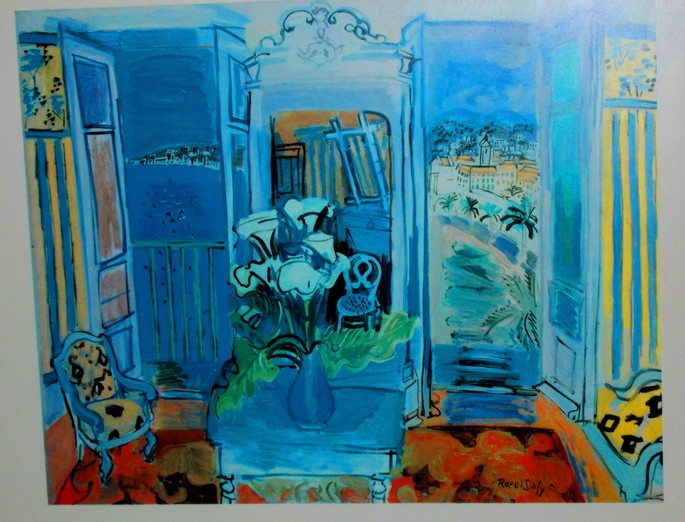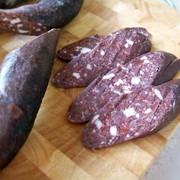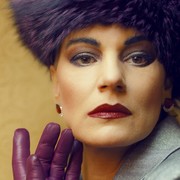In 1977, the Musée des Beaux Arts de Nice, received on deposit a set of drawings and watercolors by Raoul Dufy that enriched a remarkable collection mostly bequeathed by his wife Emilienne Dufy in 1962: "Boats in L'Estaque", 1908 "Portrait of Emilienne Dufy", 1930; "Yellow console with two windows", 1948; "Fireworks in Nice", "Casino on the Pier", "boardwalk", 1947. Since his first Fauve experiences and Cubist works until maturity.
Raoul Dufy was a painter of joy: his style, his subject matter, and his light, bright colours reflect a joy in life in creating works which impart to the viewer a sensuous delight. His work included a very large variety of media and he made no hierarchical distinction between "great art" and so-called "minor arts". Dufy's creative imagination, his fantasy, his mental energy, combine to produce a poetry that glories life in all its manifestations.
Biography
Raoul Dufy was born into a large family at Le Havre, in Normandy. When he was 18, he started taking evening classes taught by Charles Lhuillier, a student of the remarkable French portrait-painter, Ingres. There, Dufy met Raymond Lecourt and Othon Friesz with whom he later shared a studio in Montmartre and to whom he remained a lifelong friend. During this period, Dufy painted mostly Norman landscapes in watercolors.
In 1900, Raoul Dufy won a scholarship to the École nationale supérieure des Beaux-Arts in Paris, where again he crossed paths with Othon Friesz. (He was there when Georges Braque also was studying.) He concentrated on improving his drawing skills. The impressionist landscape painters, such as Claude Monet and Camille Pissarro, influenced Dufy profoundly. His first exhibition (at the Exhibition of French Artists) took place in 1901. Introduced to Berthe Weill in 1902, Dufy showed his work in her gallery. Dufy continued to paint, often in the vicinity of Le Havre, and, in particular, on the beach at Sainte-Adresse, made famous by Eugène Boudin and Claude Monet. In 1904, with his friend, Albert Marquet, he worked in Fecamp on the English Channel (La Manche).
Henri Matisse's Luxe, Calme et Volupté, which Dufy saw at the Salon des Indépendants in 1905, was a revelation to the young artist, and it directed his interests towards Fauvism. Les Fauves (the wild beasts) emphasized bright color and bold contours in their work. Dufy's painting reflected this aesthetic until about 1909, when contact with the work of Paul Cézanne led him to adopt a somewhat subtler technique. It was not until 1920, however, after he had flirted briefly with another style, cubism, that Dufy developed his own distinctive approach. It involved skeletal structures, arranged with foreshortened perspective, and the use of thin washes of color applied quickly, in a manner that came to be known as stenographic.
Dufy's cheerful oils and watercolors depict events of the period, including yachting scenes, sparkling views of the French Riviera, chic parties, and musical events. The optimistic, fashionably decorative, and illustrative nature of much of his work has meant that his output has been less highly valued critically than the works of artists who have addressed a wider range of social concerns.
Dufy completed one of the largest paintings (600 m²) ever contemplated, a huge and immensely popular epic to electricity, the fresco La Fée Électricité for the 1937 Exposition Internationale in Paris.
Dufy also acquired a reputation as an illustrator and as a commercial artist. He painted murals for public buildings; he also produced a huge number of tapestries and ceramic designs. His plates appear in books by Guillaume Apollinaire ("Bestiaire"), Stéphane Mallarmé, and André Gide.
His stage and costumes designs for Cocteau's "Le boeuf sur le toit" were inspired and amusing.
In 1909, Raoul Dufy was commissioned by Paul Poiret to design stationery for the house, and after 1912http://en.wikipedia.org/wiki/Raoul_Dufy#cite_note-1 designed textile patterns for Bianchini-Ferier used in Poiret'shttp://en.wikipedia.org/wiki/Raoul_Dufy#cite_note-2 and Charvet'shttp://en.wikipedia.org/wiki/Raoul_Dufy#cite_note-3 garments.
In the late 1940s and early 1950s Dufy exhibited at the annual Salon des Tuileries in Paris.http://en.wikipedia.org/wiki/Raoul_Dufy#cite_note-4http://en.wikipedia.org/wiki/Raoul_Dufy#cite_note-5 In 1952 he received the grand prize for painting in the 26th Venice Biennale. Dufy died at Forcalquier, France, on March 23, 1953, he was buried near Matisse in the Monastery Cemetery of Cimiez, a suburb of the city of Nice.





















